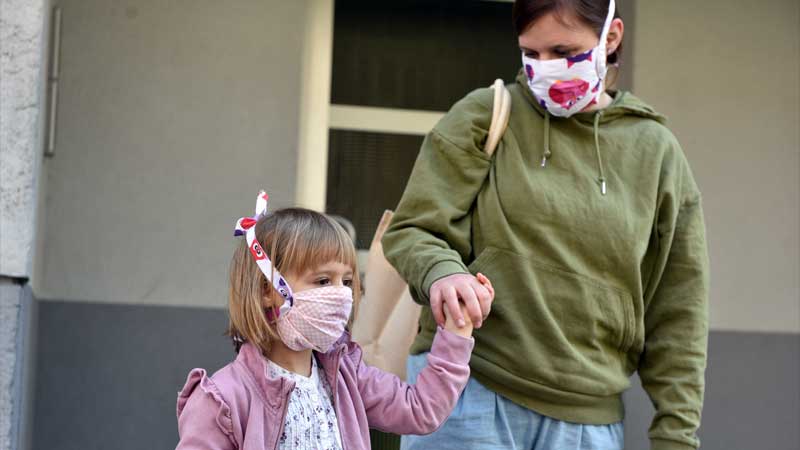What the American Rescue Plan Means for Maryland

Although far too many Maryland families continue to struggle to manage the fallout of a global pandemic that closed schools, eliminated jobs, reduced work hours, and drove retail prices up (especially for food), the American Rescue Plan (ARP) arrives at a critical time in our healing, offering a much-needed dose of optimism and the hope that we can truly begin moving forward from the virus’ economic and societal devastation.
The American Rescue Plan is a comprehensive blueprint for recovery that offers a lifeline to families struggling to meet their basic needs while creating critical investments that have the potential to significantly reduce poverty. But beyond the pandemic, we see real potential for this measure loosening, if not eliminating, the stubborn grip that poverty has had on Maryland families for generations.
In Maryland, these new tools will create more solutions for food-insecure individuals who continue to face a variety of challenges, giving them some financial equity and a little peace of mind in a still-turbulent world.
How is ARP Different From Previous Federal Assistance Efforts?
According to the Urban Institute, four aspects of the bill will reduce the projected poverty rate by more than one-third, from 13.7 percent to 8.7 percent:
- Extending the pandemic-related unemployment benefits
- Continuing the increased SNAP benefits
- Expanding and offering an advance on increased tax credits; and
- Offering an additional round of direct payments to individuals and families
And the bill is expected to be even more impactful for the communities of color that have historically experienced a disparity in poverty rates. The Urban Institute projects ARP to reduce the poverty rate by 42 percent for Black, non-Hispanic people and 39 percent for Hispanic people, as compared to 34 percent in white, non-Hispanic communities.
Michael J. Wilson, Director of Maryland Hunger Solutions, views ARP as a great example of how to maximize the impact of our tax dollars to help the most in need.
“I think the American Rescue Plan is a great dividend for Marylanders who have lost jobs, lost income, who are experiencing poverty, some maybe for the first time,” Wilson said. “We know the economy has not turned around yet, so this is a great down payment on moving things forward.”

Exactly How Will the ARP Help Our Neighbors in Need?
Four key provisions of the ARP are designed to address a lack of financial resources, one of the most stubborn root causes of hunger in our state.
Lengthening Unemployment Benefits
The extension, through September 6, 2021, provides non-traditional (gig, self-employed) workers with an additional $300/week in federal supplemental unemployment benefits, Pandemic Unemployment Assistance, and eases tax burdens on 2020 benefits received.
WHY IT MATTERS TO MARYLAND
An estimated 158,737 workers will continue to receive these benefits (according to U.S. Department of Labor Data.) And a recent study showed that unemployment insurance was associated with a 35% decline in food insecurity and a 48% decline in eating less due to financial constraints.
Extending Increased SNAP Benefits
Offering the higher benefit through September gives SNAP participants 15 percent more buying power and increases spending in local economies.
The Supplemental Nutrition Assistance Program is by far the largest and most impactful hunger-fighting tool available, in part because of its ability to expand in times of heightened need and shrink in better economic times.
- For instance, SNAP and P-EBT benefits increased by 86.4% nationally between February and September 2020, compared to the same period in 2019 (USDA).
- In addition, for every meal MFB provides, SNAP is able to provide nine.
- And every $1 in SNAP benefits translates to at least $1.50 in local economic impact.
WHY IT MATTERS TO MARYLAND
760,000 Marylanders participate in SNAP and will soon receive an extra $29 per month to spend on food. “Nearly 40 percent of SNAP participants in Maryland have incomes below 50 percent of the federal poverty line, this increase will make an immediate and significant impact on their lives,” said Katie Beltz, MFB’s Director of Client Services.
Expanding the Child Tax and Earned Income Tax Credits
Attacking financial hardship at its roots frees up critical financial resources for struggling individuals and families.
Not only has the amount of the Child Tax Credit increased (by 50-80 percent), but the program’s scope has been expanded and now includes 17-year-old children. Eligible families will see the effect of the increased Child Tax Credit as soon as July, with monthly payments ranging from $250-300. And this credit is now fully refundable, meaning low-income households will receive the full benefit.
For working adults without children, changes to the Earned Income Tax Credit nearly triples the benefit (from $540 to $1,500) and amends the eligibility thresholds (the income cap is raised to $21K, and age is lowered to 19).
WHY IT MATTERS TO MARYLAND
The Maryland Center on Economic Policy believes the changes to the Child Tax Credit will benefit 1.1 million children in the state, while the increased value of the Earned Income Tax Credit will help more than 250,000 Marylanders who work but barely make ends meet.
Offering an Additional Round of $1,400 Direct Payments
Liquid assets will help lessen the number of tough choices that many food-insecure individuals are forced to make, such as paying for childcare, utility bills, or transportation versus grocery shopping.
WHY IT MATTERS TO MARYLAND
Maryland Sens. Chris Van Hollen and Ben Cardin estimate that more than 2.5 million Maryland households are expected to receive this benefit, providing more than $6.25 billion dollars in local economic impact.
While they may not be as immediate and visible as the large-scale food distributions many people may associate with traditional hunger relief, the American Rescue Plan’s tax code changes have the potential to have a greater, longer-term impact on the Marylanders who need it the most.
“These dollars will flow through the folks who have the least income, and who have been impacted the most by the pandemic,” said Michael J. Wilson. ” In terms of being able to pay rent, utilities, or other critical costs that families are facing, this can be life-changing,” said Michael J. Wilson, Director, Maryland Hunger Solutions.
Strategic Planning for Improved Outcomes
Far too many of our neighbors in need were suffering before COVID-19 altered our world, and the pandemic has underscored the simple fact that food alone will not be enough to conquer hunger in our state.
When we launched our strategic plan in 2019, a key component was an increased focus on addressing the root causes of hunger in our state — a lack of work/under-employment, transportation issues, challenges with childcare, and other resource-based issues — the stubborn, persistent barriers that keep people trapped in seemingly endless cycles of poverty and food insecurity.

While COVID may have temporarily derailed some of those efforts, we’re in the process of updating that plan to account for the long-lasting effects of the virus.
But we’re inspired by the relief that ARP will provide to our neighbors in need. Much like food assistance frees up critical resources for families, allowing them to focus on growth, the federal support in the bill will allow the Maryland Food Bank to focus our efforts on providing additional services and resources for the people of Maryland.
The bill gives us real hope that we’ll make significant progress toward the third tenant of our mission statement: feeding people, strengthening communities, and ending hunger for more Marylanders.
“The American Rescue Plan comes at a critical point in Maryland’s history, and we are encouraged to see the federal government’s priorities aligning so closely with our own,” said Carmen Del Guercio, President & CEO of the Maryland Food Bank. “In addition to bringing more attention to the root causes of hunger, this legislation actively addresses many of these issues with concrete solutions that every Marylander should feel hopeful about.”
Get updates on our progress in the fight against hunger
Want to see how your involvement directly impacts the well-being of your neighbors in need? Get the latest news sent to your inbox.







